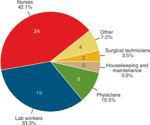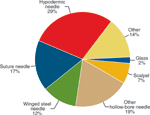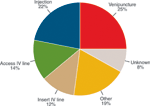Bloodborne Infections and Percutaneous Exposures
This section provides information from the CDC about two of the major occupational bloodborne infections—hepatitis B and HIV, the virus that causes AIDS. Both infections are potentially fatal. Most occupational exposures to these bloodborne illnesses occur among health care workers.
More than 8 million U.S. health care workers in hospitals may be exposed to blood or other body fluids through the following types of contact:
- Percutaneous injuries (injuries through the skin) with contaminated sharp instruments such as needles and scalpels (82%)
- Contact with mucous membranes of the eyes, nose, or mouth (14%)
- Exposure of broken or abraded skin (3%)
- Human bites (1%)
Up to 800,000 percutaneous injuries may occur annually among all U.S. health care workers (both hospital-based workers and those in other health care settings). After percutaneous injury with a contaminated sharp instrument, the average risk of infection is 0.3% for HIV and ranges from 6% to 30% for hepatitis B.
Magnitude and Trend
How many health care workers were infected with hepatitis B during 1983–1999?
 | Figure 2-10 Estimated number of occupational hepatitis B infections among U.S. health care workers, 1983-1999. Hepatitis B infections include symptomatic and asymptomatic cases. The National Notifiable Diseases Surveillance System (NNDSS) indicates a 96% decline in hepatitis B viral infections among health care workers over a 17-year period-from nearly 11,000 cases in 1983 to fewer than 400 in 1999. (Note: In the mid-1980s, health care facilities began adopting recommended universal precautions against exposure to body fluids. These were followed in 1992 with the OSHA Bloodborne Pathogens Standard [29 CFR* 1910.1030], which required employers to offer hepatitis B vaccinations to exposed workers.) (Source: CDC [2002a].) *Code of Federal Regulations. See CFR in references. |
What were the rates of hepatitis B infection among U.S. health care workers during 1993–1999?
 | Figure 2-11 Incidence rates of hepatitis B infection per 100,000 U.S. health care workers, 1993-1999. The incidence rate (rate of new infections) of hepatitis B infections generally declined about 60% from 1993 to 1999 among U.S. health care workers. These infections include both symptomatic and asymptomatic cases. (Source: CDC [2002a].) |
Occupation
Which health care workers acquired HIV/AIDS at work during 1981–2002?
 | Figure 2-12 Distribution and number of documented cases of occupational transmission of HIV among health care workers by occupation, 1981-2002. Among the cases of occupational HIV transmission reported to the HIV/AIDS Reporting System (HARS) from 1981 through December 2002, 57 cases were documented and 139 cases were possible. Most documented cases of occupational HIV transmission occurred among nurses (24 cases or 42.1%) and laboratory workers (19 cases or 33.3%). Among the documented cases of HIV following occupational exposure, 84% resulted from percutaneous exposure. (Source: CDC [2003].) |
Medical Devices
What medical devices were associated with percutaneous injuries during 1995–2000?
 | Figure 2-13 Distribution of 10,378 reported percutaneous injuries among hospital workers by medical device associated with the injury, 1995-2000. The devices most associated with percutaneous injuries among hospital workers during 1995-2000 were hypodermic needles (29% of injuries), suture needles (17%), winged steel needles (12%), and scalpels (7%). Other hollow-bore needles together accounted for 19% of injuries, glass items for 2%, and other items for 14%. (Source: CDC [2002b].) |
Hollow-Bore Needles
What medical procedures involving hollow-bore needles were associated with percutaneous injuries during 1995–2000?
 | Figure 2-14 Distribution of 6,212 reported percutaneous injuries involving hollow-bore needles in hospital workers by associated medical procedure, 1995-2000. Drawing blood from a vein (venipuncture) was responsible for 25% of percutaneous injuries involving hollow-bore needles during 1995-2000, and injections were responsible for 22%. (Source: CDC [2002b].) |
*Code of Federal Regulations. See CFR in references.

